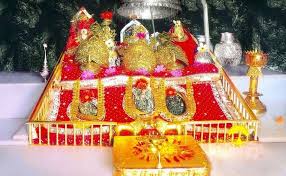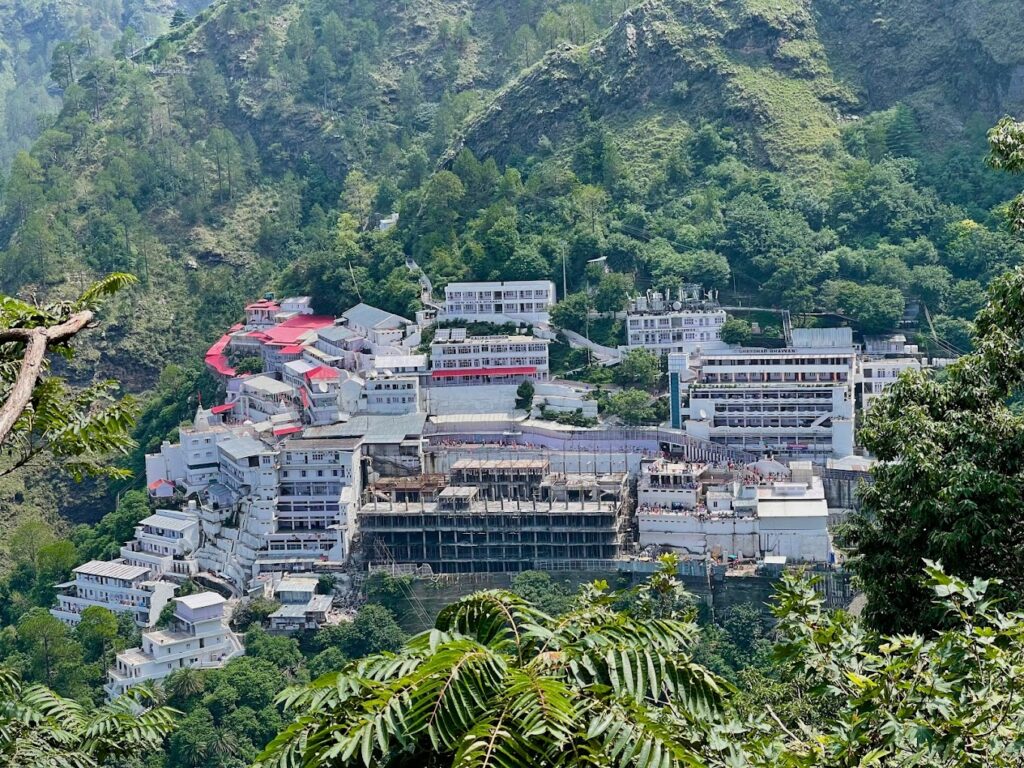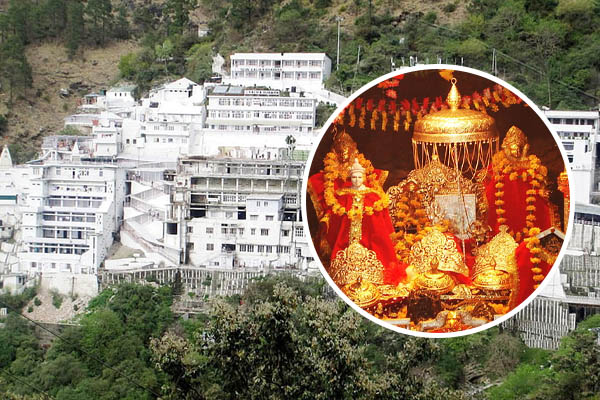
Vaishno Devi Temple
Table of Contents
Exploring Vaishno Devi Temple: A Sacred Journey to the Divine
Nestled in the serene Trikuta Mountains of Jammu and Kashmir, the Vaishno Devi Temple is one of India’s most revered pilgrimage destinations. Dedicated to Mata Vaishno Devi, an incarnation of the Hindu goddess Durga, this shrine attracts millions of devotees every year, seeking blessings, solace, and spiritual awakening. The temple is a symbol of faith, devotion, and the timeless bond between devotees and the divine.
The Legend of Vaishno Devi

The story of Vaishno Devi is rooted in Hindu mythology. It is believed that Vaishnavi, a manifestation of Goddess Durga, was born to restore dharma and eliminate evil forces. While meditating in the Trikuta Mountains, Vaishnavi was pursued by Bhairon Nath, a demon. To protect herself and maintain her vow of celibacy, she fled into the caves of the mountain.
Ultimately, she manifested her divine powers to vanquish Bhairon Nath. Before his death, Bhairon Nath sought forgiveness, and the goddess granted him a boon that devotees would visit his shrine after hers, completing their pilgrimage. Today, the Bhairon Nath Temple is an essential part of the Vaishno Devi yatra.
The Journey to Vaishno Devi
Reaching the Vaishno Devi Temple is as much about the spiritual journey as the destination. The trek begins at Katra, a small town located approximately 50 kilometers from Jammu. Here’s what makes the journey unforgettable:
The Trek
- Distance: The trek from Katra to the Bhawan (the sanctum sanctorum) is around 13 kilometers.
- Route Options: Devotees can choose to walk, ride ponies, take a palanquin, or use helicopter services for the journey.
- Scenic Beauty: The trail offers breathtaking views of the Trikuta Mountains, lush greenery, and a serene atmosphere. The chanting of “Jai Mata Di” by fellow pilgrims adds to the spiritual ambiance.
Facilities Along the Way
The route is equipped with rest stops, eateries, and medical facilities, ensuring a comfortable journey for pilgrims. Battery-operated vehicles are also available for elderly and differently-abled devotees.
The Divine Experience at the Bhawan
The main temple, or Bhawan, houses the sacred pindis, representing the three forms of Goddess Durga:
- Maha Kali – Symbolizing strength and power.
- Maha Lakshmi – Representing wealth and prosperity.
- Maha Saraswati – Denoting wisdom and knowledge.
Pilgrims offer their prayers and seek blessings, feeling an immense sense of peace and fulfillment in the goddess’s presence.
Other Attractions Around Vaishno Devi
- Bhairon Nath Temple: A 2.5-kilometer trek from the Bhawan leads to this temple, considered a vital part of the pilgrimage. It is believed that the yatra is incomplete without paying homage here.
- Ardhkuwari Cave: Located midway on the trek, this cave is where Mata Vaishno Devi meditated for nine months.
- Charan Paduka: A sacred site where the goddess’s footprints are believed to be imprinted.
- Sanji Chhat: A scenic spot near the Bhawan offering panoramic views of the surrounding valleys.
Best Time to Visit
The Vaishno Devi Temple is open year-round, but certain seasons enhance the experience:
- Summer (March to June): Pleasant weather makes it ideal for trekking.
- Navratri (March/April and September/October): A spiritually charged time with special celebrations.
- Winter (November to February): Snow-covered trails offer a unique and serene experience, though the trek can be challenging.
Tips for Pilgrims
- Plan Ahead: Register online or at the Katra registration counter to get your Yatra Parchi (travel slip).
- Stay Hydrated: Carry water and light snacks for the trek.
- Wear Comfortable Clothing: Opt for trekking-friendly attire and footwear.
- Respect Local Customs: Maintain cleanliness and follow temple protocols.
Significance of the Vaishno Devi Yatra
The Vaishno Devi pilgrimage is not just a religious journey but also a personal one, reflecting devotion, determination, and faith. For many, it is a transformative experience, bringing clarity and inner peace. The goddess is believed to fulfill the wishes of her devotees, making it a site of immense spiritual significance.
Conclusion
A visit to the Vaishno Devi Temple is a once-in-a-lifetime experience that combines faith, nature, and culture. Whether you’re seeking divine blessings, inner peace, or simply the joy of being in a sacred environment, this journey has something profound to offer. So, pack your bags, prepare your heart, and set out on this incredible spiritual adventure to Vaishno Devi, where faith meets the divine.
History of Vaishno Devi Temple
The Vaishno Devi Temple, nestled in the Trikuta Mountains of Jammu and Kashmir, is one of the holiest shrines in India. The origins of this revered temple are steeped in mythology, spirituality, and folklore. Its rich history highlights the timeless devotion of millions of pilgrims and the enduring sanctity of the goddess it honors.
History of Vaishno Devi Temple
The Vaishno Devi Temple, nestled in the Trikuta Mountains of Jammu and Kashmir, is one of the holiest shrines in India. The origins of this revered temple are steeped in mythology, spirituality, and folklore. Its rich history highlights the timeless devotion of millions of pilgrims and the enduring sanctity of the goddess it honors.
Mythological Origins
The story of Vaishno Devi is intricately connected to the Hindu trinity of goddesses – Maha Kali, Maha Lakshmi, and Maha Saraswati. According to legends:
- Birth of Vaishnavi: The goddess was born as Vaishnavi, a human incarnation, to fulfill her divine purpose of eradicating evil and upholding dharma. Her life was dedicated to meditating and serving the needy.
- Encounter with Bhairon Nath: During her penance in the Trikuta Mountains, Vaishnavi was pursued by a demon, Bhairon Nath, who sought her hand in marriage. To escape his advances, she fled to the caves of the mountain.
- Divine Intervention: When Bhairon Nath continued to chase her, Vaishnavi manifested her divine form and beheaded him. His severed head fell at a distant spot where the Bhairon Nath Temple now stands. Before dying, Bhairon Nath repented, and the goddess forgave him, granting his wish that devotees must visit his temple to complete their pilgrimage.
This legend established Vaishno Devi as a manifestation of the divine feminine energy and a protector of righteousness.
Historical Evidence
While the exact timeline of the Vaishno Devi Temple’s origins is unclear, historical records suggest the following:
- Mahabharata Connection: It is believed that the Pandavas visited the Vaishno Devi shrine during the Kurukshetra war. Arjuna, one of the Pandavas, meditated here and sought blessings from the goddess for victory.
- Discovery of the Cave: According to folklore, the shrine was rediscovered by a Brahmin priest named Pandit Shridhar. Guided by a divine vision, he found the cave and became the first pujari (priest) of the temple.
- Mughal and Dogra Influence: Despite the Mughal invasions, the temple remained untouched due to its remote location. Later, the Dogra rulers of Jammu patronized the shrine, contributing to its development and maintenance.
The Sacred Cave
The temple is located in a cave within the Trikuta Mountains. This cave is believed to be where Goddess Vaishno Devi meditated and eventually vanquished Bhairon Nath. Inside the cave, devotees worship three naturally formed pindis (rock formations) that symbolize the goddesses Maha Kali, Maha Lakshmi, and Maha Saraswati.
The cave has undergone modifications over the years to accommodate the growing number of pilgrims. Despite these changes, the sanctity and essence of the shrine remain intact.
Modern-Day Pilgrimage
In recent decades, the Vaishno Devi Temple has become one of the most visited religious sites in India. The Shri Mata Vaishno Devi Shrine Board (SMVDSB), established in 1986, manages the temple and ensures a seamless experience for pilgrims.
- Infrastructure Development: The board has introduced paved pathways, rest houses, and battery-operated vehicles to make the pilgrimage accessible to all. Helicopter services are also available for those who cannot undertake the trek.
- Global Recognition: The temple is recognized as a significant center of spiritual tourism, attracting millions of devotees from India and abroad.
Significance of Vaishno Devi
The Vaishno Devi Temple is not just a religious site but a symbol of faith, resilience, and unity. The goddess is revered by people of all castes, creeds, and religions, making the shrine a testament to India’s pluralistic culture.
Spiritual Beliefs:
- The goddess is believed to fulfill the wishes of her devotees.
- Visiting the temple is considered a transformative experience, bringing inner peace and divine blessings.
Cultural Impact:
- The temple has inspired art, literature, and music over the centuries, further enriching India’s cultural heritage.
Conclusion

The Vaishno Devi Temple is a beacon of spirituality and devotion, rooted in ancient mythology and enriched by centuries of faith. Whether viewed as a religious journey or a cultural exploration, the shrine continues to captivate the hearts of millions. Its history, interwoven with myth and reality, makes it a timeless testament to the enduring power of faith.
Jai Mata Di
Source Vaishno Devi Temple
Indian Temple Vaishno Devi Temple